To capture stunning reveal shots from above, you'll need to master five key secrets. First, meticulously plan your flight path, scouting locations and practicing routes. Second, perfect your timing and speed control for smooth, dramatic movements. Third, harness natural light, especially during golden hours, to enhance textures and create atmosphere. Fourth, use leading lines in your composition to guide the viewer's eye towards the main subject. Finally, incorporate motion in your subjects to add dynamism and interest to your shots. By applying these techniques, you'll elevate your aerial videography and create enchanting visual stories that leave audiences wanting more.
Key Takeaways
- Plan your flight path meticulously, scouting locations and practicing routes for optimal reveal shots.
- Master timing and speed control, using smooth movements and intelligent flight modes for consistent reveals.
- Utilize natural light, especially during golden hours, to enhance textures and create dramatic shadows.
- Compose shots with leading lines to guide viewers' eyes and create depth in your aerial reveals.
- Incorporate motion in subjects to add dynamism, using tracking techniques and creative camera angles.
Plan Your Flight Path
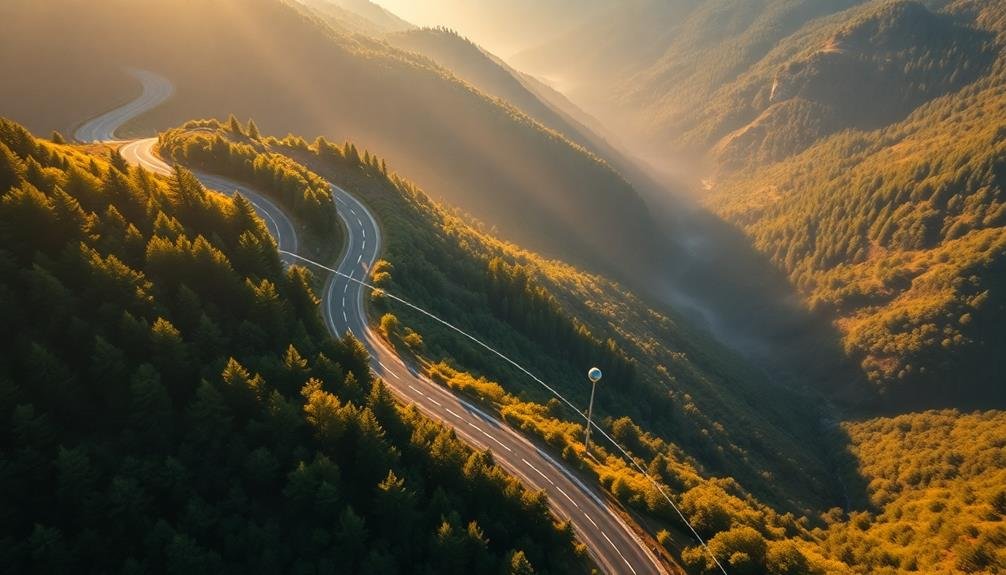
Frequently, the key to a successful reveal shot lies in meticulous planning of your drone's flight path. Before you take off, envision the scene you want to capture and map out your drone's trajectory. Reflect on the starting point, end point, and any obstacles or points of interest along the way.
Begin by scouting the location on foot or using satellite imagery. Identify potential hazards like trees, power lines, or buildings that could interfere with your flight. Choose a starting position that obscures the main subject, then plot a path that gradually reveals it in a dramatic way.
Think about the speed and altitude changes you'll need to make during the flight. Slow, steady movements often work best for reveal shots, but don't be afraid to experiment with different speeds and angles. You might want to start low and gradually ascend, or begin high and descend as you approach your subject.
Practice your planned route several times before attempting the final shot. This will help you refine your movements and timing. Remember to reflect on lighting conditions and how they'll change as you move through the scene.
Master Timing and Speed

In line with the importance of planning your flight path, mastering timing and speed is vital for creating stunning reveal shots.
You'll need to carefully control your drone's movement to achieve the desired effect. Start by practicing smooth acceleration and deceleration, as abrupt changes can ruin the shot's flow.
Experiment with different speeds to find what works best for your subject. Slower speeds often work well for gradual reveals, while faster speeds can create dramatic effects. However, be cautious not to move too quickly, as this can result in blurry footage or disorienting viewers.
Timing is essential for reveal shots. You'll want to sync your drone's movement with the subject's action or the unfolding scene. This might mean waiting for the perfect moment to start your flight or coordinating with actors or events on the ground.
Consider using your drone's intelligent flight modes, such as waypoints or tracking, to guarantee consistent speed and timing. These features can help you achieve more precise and repeatable shots.
Remember to account for factors like wind speed and direction, which can affect your drone's movement and timing.
Utilize Natural Light
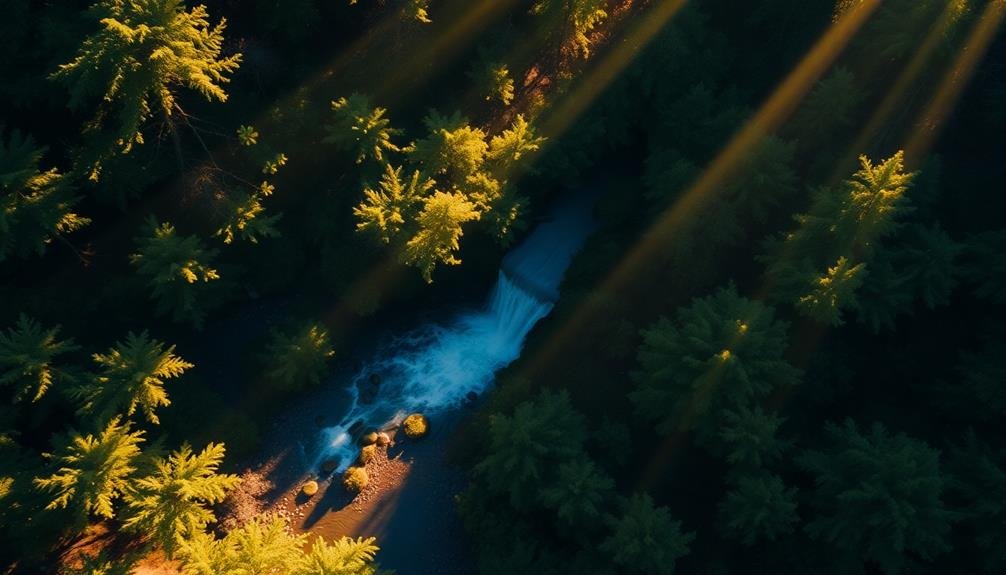
While mastering timing and speed is key, the quality of light in your reveal shots can make or break your footage. Natural light is your best friend when it comes to creating stunning reveal shots from above. You'll want to plan your shoots during the golden hours – just after sunrise or before sunset – when the sun casts a warm, soft glow across the landscape.
During these times, you'll benefit from long shadows that add depth and dimension to your shots. The low angle of the sun also creates a beautiful interplay of light and shadow, enhancing textures and contours in your subject matter. To make the most of natural light, position yourself so that the sun is behind or to the side of your drone. This will help prevent lens flare and overexposure.
Don't shy away from overcast days, either. Cloudy skies can act as a giant softbox, diffusing light evenly across your scene and eliminating harsh shadows. This can be particularly useful when shooting in urban environments or areas with reflective surfaces.
Remember to adjust your camera settings to compensate for changing light conditions, and always keep an eye on your histogram to guarantee proper exposure.
Compose With Leading Lines
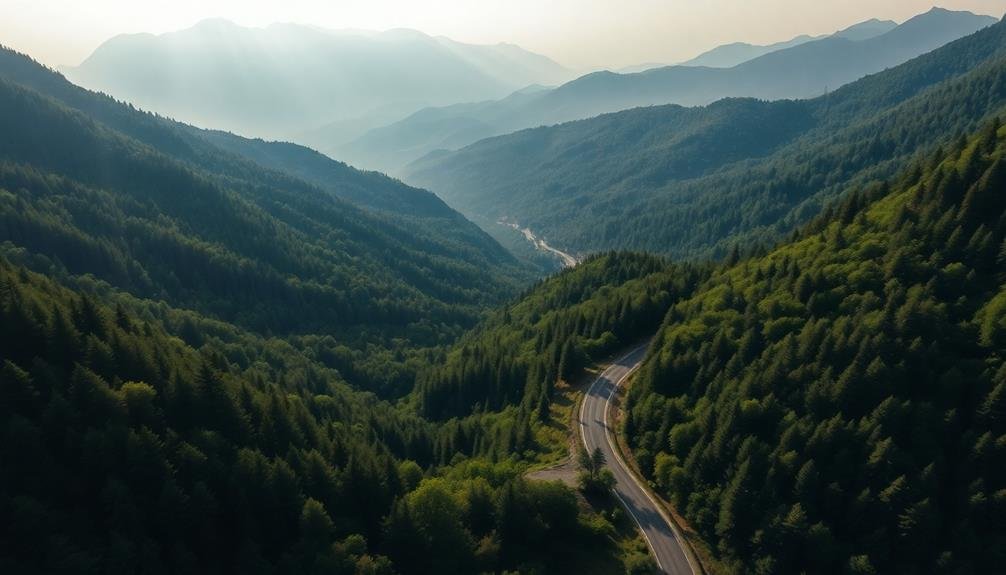
Leading lines are one of the most powerful tools in a filmmaker's compositional toolkit. When creating reveal shots from above, you'll want to use these lines to guide your viewer's eye through the frame and towards your main subject.
Look for natural lines in the landscape, such as roads, rivers, or shorelines. These can create a sense of depth and draw attention to specific areas of your shot.
As you compose your reveal, consider how you can incorporate man-made structures like buildings, bridges, or fences to create strong geometric patterns. These elements can add visual interest and help direct the viewer's gaze.
Remember to experiment with different angles and heights to find the most compelling composition.
When using leading lines, try to position them so they converge towards your main point of interest. This technique creates a sense of movement and guides the audience's attention exactly where you want it.
Don't be afraid to use diagonal lines for a more dynamic and energetic feel. By mastering the art of composing with leading lines, you'll create reveal shots that aren't only visually stunning but also effectively communicate your intended message.
Incorporate Motion in Subjects
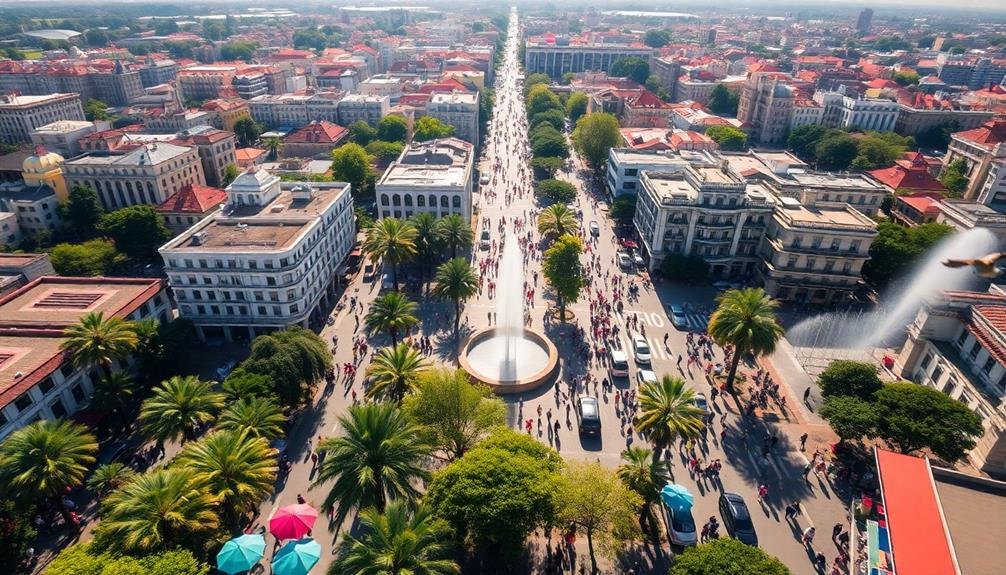
Motion breathes life into your reveal shots, transforming static scenes into dynamic visual experiences. When incorporating motion in subjects, you're adding an extra layer of interest to your aerial photography. Look for opportunities to capture movement, whether it's people walking, cars driving, or natural elements like flowing water or swaying trees.
To effectively incorporate motion, consider these techniques:
- Use a slower shutter speed to create motion blur.
- Track moving subjects with your drone's camera.
- Utilize the drone's movement to create a sense of motion.
Experiment with different angles and heights to showcase motion in unique ways. For instance, capture a bird's-eye view of a busy intersection or follow a winding river from above.
Don't forget to adjust your camera settings to freeze or blur motion as desired. When planning your shot, anticipate where motion will occur and position your drone accordingly. This foresight will help you capture the perfect moment as it unfolds.
Frequently Asked Questions
What Drone Equipment Is Best for Beginners Learning Aerial Photography?
You'll want to start with an entry-level drone like the DJI Mini 2 or Mavic Air 2. They're user-friendly, have good cameras, and offer stable flight. Don't forget extra batteries and a carrying case for your adventures.
How Do You Handle Unexpected Weather Changes During a Shoot?
When unexpected weather hits, you'll need to adapt quickly. Always check forecasts beforehand, but be prepared to change plans. Bring protective gear for your equipment, and don't hesitate to reschedule if conditions become unsafe for flying.
Are There Legal Restrictions for Drone Photography in Urban Areas?
You'll face legal restrictions for drone photography in urban areas. Check local laws, obtain necessary permits, and follow FAA regulations. Don't fly over people, respect privacy, and avoid restricted airspace. Always prioritize safety and compliance.
How Can You Stabilize Footage in Post-Production for Smoother Reveal Shots?
You can stabilize footage in post-production by using software like Adobe Premiere or DaVinci Resolve. Apply warp stabilizer effects, adjust smoothness settings, and crop slightly. Don't forget to use a high shutter speed while filming for better results.
What Safety Precautions Should Be Taken When Flying Drones Near Wildlife?
You'll need to keep your distance from wildlife when flying drones. Don't disturb animals, follow local regulations, and avoid nesting areas. Always prioritize the safety of creatures over getting the perfect shot. Be respectful and cautious.
In Summary
You've now got the tools to create breathtaking reveal shots from above. Remember, it's all about planning, timing, and composition. Use natural light to your advantage, and don't forget to incorporate motion for added drama. With practice, you'll master these techniques and develop your own unique style. So grab your drone, head out, and start capturing those stunning aerial reveals. The sky's the limit for your creativity!

As educators and advocates for responsible drone use, we’re committed to sharing our knowledge and expertise with aspiring aerial photographers.
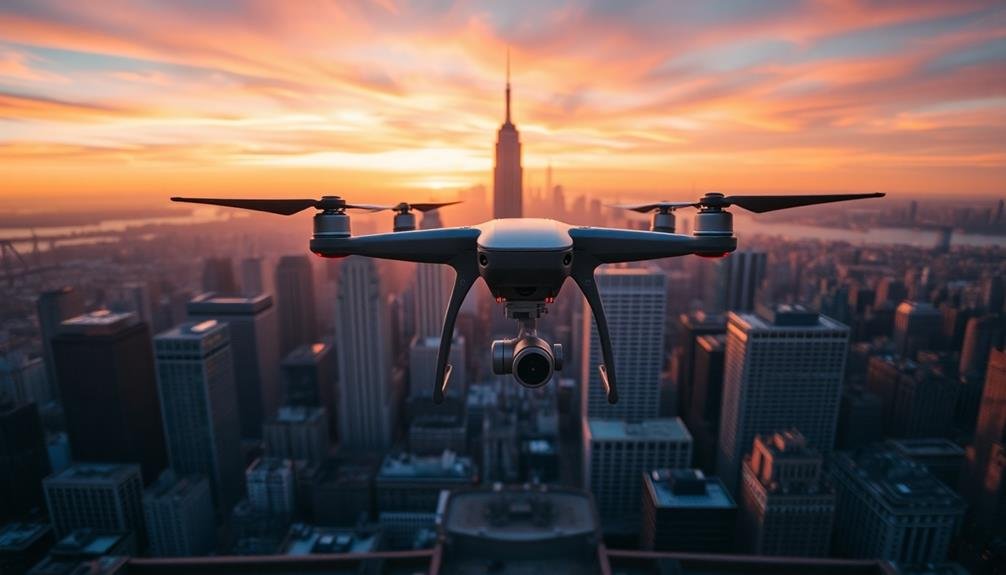



Leave a Reply